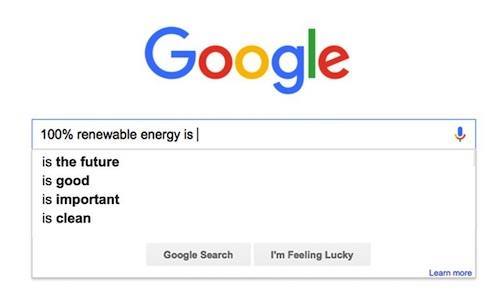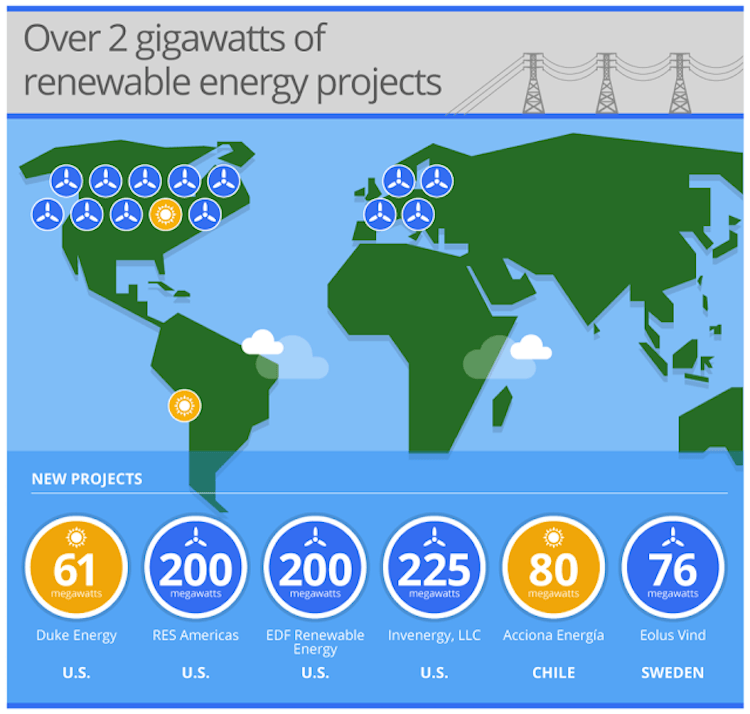

Google is another step closer in their goal of powering 100 percent of their operations with clean energy. Today, the search giant announced “the largest, and most diverse, purchase of renewable energy ever made by a non-utility company.” The massive purchase adds an additional 842 megawatts of renewable energy capacity to power their data centers, which enable the 1.7 billion Google users worldwide to surf the web.
“Across three countries, we’re nearly doubling the amount of renewable energy we’ve purchased to date,” Google said. “We’re now up to 2 gigawatts—the equivalent to taking nearly 1 million cars off the road.”
Or, as noted by Wired, Google now has enough juice to power two San Franciscos.
Google’s renewable energy mix will come from six different sources from all over the world, such as 61 megawatts of solar from Duke Energy in North Carolina, 76 megawatts of wind from Västernorrland County in Sweden and 80 megawatts of solar from Chile.
“These long-term contracts range from 10-20 years and provide projects with the financial certainty and scale necessary to build these wind and solar facilities—thus bringing new renewable energy onto the grid in these regions,” Google said. “For our part, these contracts not only help minimize the environmental impact of our service—they also make good business sense by ensuring good prices.”
Google estimated that the projects will generate an average of about 7.4 billion kilowatt hours of power, the Associated Press reported. The company hasn’t disclosed how much the purchase will cost.
Wired calculated that, in total, 37 percent of the energy for Google’s data centers will now come from renewable sources.
.@Google sets goal to power all operations with 100% renewable energy https://t.co/odURx1Zf0N #go100percent #COP21 pic.twitter.com/OW2loQQUAc
— Here Now (@weareherenow) December 3, 2015
The announcement was made as world leaders at the COP21 climate talks in Paris hammer down on ways to cut carbon emissions.
“It’s an opportune time to make a strong statement,” Gary Demasi, Google’s director of data center energy, told the Associated Press.
As EcoWatch reported in July, Google already made pledges to slash their carbon footprint before the Paris climate talks, and was one of the 13 companies to commit a combined $140 billion to the White House’s American Business Act on Climate Pledge.
Google’s latest move doesn’t just benefit their bottom line—it’s also a benefit to a clean energy future.
“We hope that our efforts play a small part in boosting all of us in the race to solve climate change,” Google said in today’s announcement.
News of Google’s renewable energy purchases was hailed by environmental advocacy group Greenpeace.
“We don’t need to wait for a clean energy miracle. Google has repeatedly demonstrated that renewables are ready to meet our energy needs today,” Greenpeace Senior IT Analyst Gary Cook said. “The fact that some of the world’s most innovative companies are moving quickly towards a renewable energy future should encourage the negotiators at the climate talks to increase their level of ambition. We also need all governments to get rid of policies that favor fossil fuels and block access to a renewable supply of energy, which Google and other leading companies need to power their growth.”
Several other prominent internet companies such as Apple and Facebook have also committed to use 100 percent renewable energy to power their data centers.
Greenpeace has compiled a report called the Click Clean Scorecard that details the progress of major internet companies toward their renewable energy goals.
According to Greenpeace, as of Dec. 1, tech companies that have adopted a 100 percent renewable goal include: Adobe, Apple, Amazon Web Services, Box, Equinix, Digital Realty Trust, Facebook, Google, LinkedIn, Microsoft, Naver, Rackspace, Salesforce and Switch Communications.
Alongside its renewable energy goals, Google has already made several other strides to go green. In June, the Mountain View-based corporation announced it was building its newest data center in Alabama on the site of a coal-fired power plant and committed to powering the facility with 100 percent renewable energy.
In August, Google launched Project Sunroof to make it easier for homeowners switch to solar.
Stick it where the sun shines! Project Sunroof can help you make the switch to solar → http://t.co/Jv0xbrm8EJ pic.twitter.com/djAaCTArWc
— Google (@Google) August 17, 2015
“Beyond our efforts to power our own operations with renewables, we’ve made separate agreements to fund $2.5 billion into 22 large-scale renewable energy projects over the last five years, from Germany to Kansas to Kenya,” Google added in today’s announcement.
“These investments have been in some of the largest and most transformative renewable energy projects in the world with a goal to help drive renewable energy development not only as a customer but as an investor, and bring down costs for everyone.”
YOU MIGHT ALSO LIKE
Dubai to Make Rooftop Solar Mandatory by 2030
25 American Companies Go Big With Solar
100% Renewable-Powered World ‘Technically Feasible and Economically Viable’ by 2030
Morocco’s Giant Solar Plant to Bring Energy to 1 Million People

 233k
233k  41k
41k  Subscribe
Subscribe 
